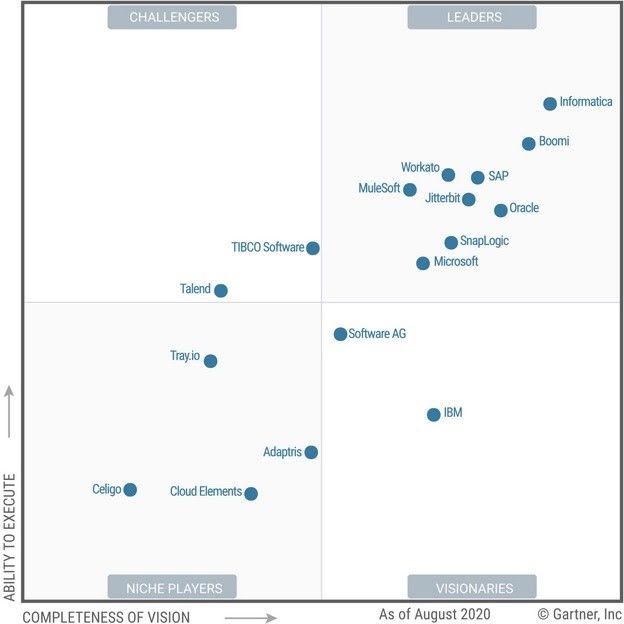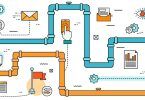Every year organizations and clients alike eagerly anticipate the research findings that are published by world-renowned IT consulting firm Gartner, and this year is no different. Reported in their Magic Quadrants, these results feature the top vendors in their specific category and highlight their strengths in the market as well as some potential challenges they might face over the course of the upcoming year.
The Enterprise Integration Platform as a Service Magic Quadrant continues to include a wide range of vendors, with almost 20 different contenders this year. Providers of enterprise integration platform as a service continue to broaden their offerings, covering increasing ranges of integration scenarios for the modern enterprise.
What is Enterprise Integration Platform as a Service?
Gartner defines an enterprise iPaaS (EiPaaS) as a “suite of integration platform as a service (iPaaS) technologies. An iPaaS provides capabilities to enable subscribers to implement integration projects involving any combination of cloud-resident and on-premises endpoints, including APIs, mobile devices and the Internet of Things (IoT).”
When is an iPaaS and EiPaaS? Gartner considers an iPaaS an EiPaaS if it:
- Is designed to support enterprise-class integration initiatives.
- Provides integrations that the subscriber can develop and manage independent of the provider’s professional services.
- Offers capabilities for executing multiple integration scenarios.
In order to qualify for inclusion in this quadrant, vendors must deliver a service that meets these characteristics:
- Is a cloud service.
- Is available either by subscription or over internet technologies.
- Includes either the sharing of physical resources between logically isolated subscribers, self-service management and provisioning by subscribers, or some instrumentation for tracking the use of resources.
- Multiple message or data delivery styles such as batch, API-based, event-based, or message and data validation.
- Must encapsulate underlying physical or virtual machines, their management and direct costs, and their procurement.
- Allows connectivity to different endpoints that are both on-premises and cloud-based.
Magic Quadrant for Enterprise Integration Platform as a Service 2020
Here is the Magic Quadrant for Enterprise iPaaS:
Results at-a-glance
In order to fully utilize the results of the Magic Quadrant, it’s necessary to understand each category:
- Leaders: Innovative giants who demonstrate depth across the full range of enterprise iPaaS technologies.
- Challengers: Companies with an established presence along with a variety of product capabilities.
- Visionaries: Innovators with a strong understanding of both current and future market trends.
- Niche Players: Specialists with a hyper-focus on a small market.
With these category definitions in mind, below are the results comparing last year’s Magic Quadrant to this year’s final results.
| 2020 Results | 2019 Results | |
|---|---|---|
| Leaders | Informatica Boomi SAP Oracle Workato Jitterbit SnapLogic MuleSoft Microsoft | Informatica Dell Boomi Jitterbit SnapLogic Oracle Workato Microsoft MuleSoft |
| Challengers | TIBCO Software Talend | TIBCO Software |
| Visionaries | IBM Software AG | SAP IBM Software AG Adaptris |
| Niche Players | Tray.io Adaptris Cloud Elements Celigo | Cloud Elements Celigo Azuqua Moskitos |
Dominant leaders
Although many top vendors remained consistent in the Leader category of this Magic Quadrant, there were some shifts in their relevant positions as certain providers aimed to level the playing field.
Informatica
This year’s Leader is powerhouse Informatica, whose Intelligent Cloud Services and software counterparts can be managed on a common platform environment based on a hybrid integration platform model. Their EiPaaS has a leading market share thanks to Informatica’s enterprise-wide use and HIP approaches for integration in diverse use cases.
The company has a strong focus on automation and intelligence within cloud-native integration capabilities, which speaks well to clients looking for augmented and hybrid strategies. Their use of AI for automation and intelligence continue to keep them ahead of the curve, maintaining their top spot.
Boomi
Boomi, a wholly owned subsidiary of Dell Technologies, continues to hold a commanding spot not far behind thanks to its continued evolution of managed and professional services as well as its strategic acquisitions.
One of Boomi’s biggest strengths is its ability to closely follow and understand market trends, building up a rich platform that provides appeal for both midsize and large organizations. Its ability to provide a unified user experience as well as its market traction ensure that customers continue to come back again and again. With an ambitious roadmap of both business and technology goals, Boomi’s lead will only continue to grow.
SAP
Rounding out the top three Leaders is SAP, whose SAP Cloud Platform Integration Suite provides a full range of integration capabilities and RPA services. Thanks to a combination of a large installed base of business applications and its impressive history in integration software, SAP currently features one of the most comprehensive EiPaaS offerings available.
With a 59% increase in revenue over the course of the last year, SAP greatly outperformed the iPaaS market, positioning the company to capture a larger share of the market over the coming year.
Enterprise Integration Platform as a Service
While the main Leaders in the Enterprise Integration Platform as a Service Magic Quadrant maintained their positions, the shift in some of the vendors this year is beginning to show that it is crucial for organizations to continue to adapt and evolve their offerings and technologies.
- Learn where the market stands and where it’s going
- Evaluate vendor strengths
- Make note of vendor challenges
Additional resources
Want to view more Magic Quadrants? Explore these resources:
- The 2020 Gartner Magic Quadrant for Data Quality Solutions
- The 2020 Gartner Magic Quadrant for Data Center and Cloud Networking
- The 2020 Gartner Magic Quadrant for Application Security Testing
- The 2020 Gartner Magic Quadrant for Cloud Infrastructure and Platform Services
- Gartner® Magic Quadrant™ for ITSM
- The Gartner Magic Quadrant for SIEM
- The Gartner Magic Quadrant for Analytics and Business Intelligence Platforms
These postings are my own and do not necessarily represent BMC's position, strategies, or opinion.
See an error or have a suggestion? Please let us know by emailing blogs@bmc.com.







